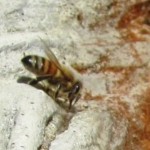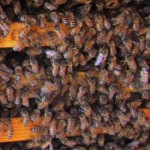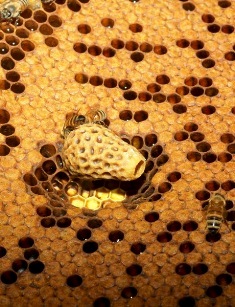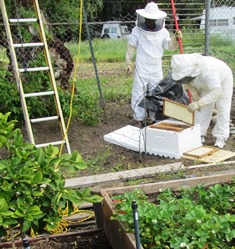Could Probiotics Help Honeybees Recover from Nosema?
Nosema apis is a tiny one-cell parasite recently reclassified as a fungus. It causes a serious infection in bees that disrupts the health of the bee gut. The sick bee becomes not only disoriented and unable to do its normal activities such as foraging or caring for bee larva.
Nosema is one, among many threats, to the global honeybee population. The infection has been associated with colony collapse disorder. But now science has shown that healing and improved survival rates from nosema (also known as nosemosis) is possible through the aid of probiotics.
In most instances, the fungus (that bees pick up as they ingest their food) causes no harm. But stress seems to create conditions for the fungus to invade and wreak havoc on the bee’s immune system. Just as probiotics support human gut microbiota (the microbe population in the human intestine) so, too, do probiotics appear to help the bee microbiota to better deal with a nosema infection.
In a Canadian study conducted by scientists at Université Laval in Quebec City, researchers discovered that they could lower the death rate of the bees suffering from nosema from 20 to 40 percent as compared to a control group by treating the sick bees with probiotics. In particular, a probiotic (P. apium) seemed to work best in the study.
Developing probiotics with specific microbes to contend with nosema is promising. But for beekeepers and scientists searching for the causes of colony collapse disorder, the work goes on to identify sources of stress that adversely affect the immune system of bees. For more information, see, https://www.sciencedaily.com/releases/2018/05/180517113819.htm
________________________________________________________________________
If you enjoy reading about gardening and farming topics, check out my Henny Penny Farmette series of mysteries: A BEELINE TO MURDER, THE MURDER OF A QUEEN BEE, and A HIVE OF HOMICIDES (Kensington Publishing).
Each book is chocked full of tips for gardening, keeping bees and chickens, and growing heirloom fruits and vegetables. There are also plenty of delicious recipes to try. Find these books in hardcover, paperback, ore ebook formats on Amazon.com, Barnes & Noble.com, Walmart.com and other online retailers or purchase at traditional bookstores everywhere.–Meera Lester
A BEELINE TO MURDER (#1) https://tinyurl.com/y6ue28xb
THE MURDER OF A QUEEN BEE (#2) http://tinyurl.com/yd7pz7af
A HIVE OF HOMICIDES (#3) http://tinyurl.com/ya5vhhpm
Swarming Season Has Arrived!
What’s not to love about spring? It’s only the middle of April and already we’ve seen several honeybee swarms. Swarming is how the bees reproduce their colonies and most often occurs during the warm days of early spring.
My neighbor, whom I’ve often called a world-class beekeeper (his father kept honeybees in Lebanon and taught him well) permitted me to keep his bee swarm that alighted in my apricot tree. He also generously donated a super (hive box) with some frames that already had wax, honey, and capped brood–all from his own apiary.
The newly housed honeybee workers delight in foraging on the various types of lavender (Spanish, English, and French perfume) that I’ve planted around the farmette. The colony will build up the wax and make honey while the nursemaid bees will care for the brood.
My husband, the architect-turned-farmer/beekeeper, has constructed a unique bee house for the hives. It will keep the bee boxes dry during winter rains and out of reach of marauding animals (skunks and raccoons). Resting on a platform that Carlos built on top of a newly installed brick floor, the hives are not within easy reach of the ever present ant population.
Alas, the bees weren’t about to wait until Carlos finished building their house. The swarm happened when the bees were ready to take flight (some 60 percent of the workers with their old queen) flew into our apricot tree.
If you see a swarm, call your local beekeeping association (or any store that carries local honey) for the name of a beekeeper. Avoid the temptation of spraying water or anything else on the swarm. Permit the beekeeper to safely remove the swarm.
For a beekeeper, rescuing a swarm is a truly exhilarating experience. Often a swarm consists of thousands to tens of thousands of honeybees. Beekeepers routinely rescue swarms from where bees have temporarily clustered while the bee scouts seek a permanent home. The beekeeper can shake them into a prepared hive box, leaving the box at the hive cluster site until all the bees are inside. At that point, the beekeeper takes the new hive to his apiary.
The beleaguered honeybees (whose populations have been decimated by the Varroa mite, weakened immune systems, and Colony Collapse Disorder) need help to survive and increase their populations. We need them, too! Without their pollination of fruit, nut, and other crops, our own food sources diminish.
Saving the honeybees is a good practice whenever possible because doing so ensures abundance and diversity in the plants we eat. Whenever I see a cluster of bees in a tree I feel joyful and celebratory. Is it any wonder that swarming season is my favorite time of the year?
 Facebook
Facebook Goodreads
Goodreads LinkedIn
LinkedIn Meera Lester
Meera Lester Twitter
Twitter










